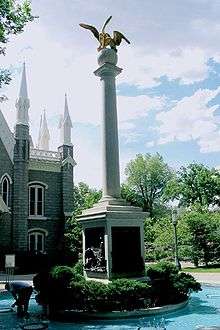Miracle of the gulls
The miracle of the gulls is an 1848 event often credited by Latter-day Saints ("Mormons") for saving the Mormon pioneers' first harvest in the Salt Lake Valley. According to Mormon folklore, seagulls miraculously saved the 1848 crops by eating thousands of insects that were devouring their fields.
Traditional story


After Brigham Young led the first band of Latter-day Saints into what is now Salt Lake City, Utah, the pioneers had the good fortune of a relatively mild winter. Although late frosts in April and May destroyed some of the crops, the pioneers seemed to be well on their way to self-sufficiency. Unfortunately, swarms of insects appeared in late May.
These insects, now called "Mormon crickets" because of this incident, are not true crickets, but instead belong to the katydid family. Having ornamental wings, they are unable to fly, but instead can travel in huge swarms. Mormon crickets eat all plant material in their path, but they also cannibalize any insects that die on the way, including their own species. They are known to cyclically swarm in some areas of the Mountain West, especially in Utah and Nevada. These insects threatened the livelihood of the Mormon pioneers; stomping on the pests did not dissuade them from entering farms as others would advance. This is a reproductive strategy similar to mast reproduction in oaks, overwhelming predators with sheer numbers allowing a percentage of the population to survive to reproduce. Mormons, prolific journal writers, often cast this disaster in Biblical terms like the 8th plague of locusts.
According to traditional accounts,[1] legions of gulls appeared by June 9, 1848. It is said that these birds, native to the Great Salt Lake, ate mass quantities of crickets, drank some water, regurgitated, and continued eating more crickets over a two-week period. The pioneers saw the gulls' arrival as a miracle, and the story was recounted from the pulpit by church leaders such as Orson Pratt and George A. Smith (Pratt 1880, p. 275; Smith 1869, p. 83). The traditional story is that the seagulls annihilated the insects, ensuring the survival of some 4,000 Mormon pioneers who had traveled to Utah. For this reason, Seagull Monument was erected and the California gull is the state bird of Utah.
Critical analysis
The traditional story is somewhat controversial and contains what some consider contradictions with modern research. Some historians believe that the gulls were neither as widespread nor as effective against the insects as is often supposed (Hartley 1992, p. 137). Ornithologists do not regard the reported behavior of the birds as particularly unusual.
Many pioneer journals recount the frosts, the swarms of insects, but no gulls. From these differing accounts it seems that gull intervention might have occurred in relatively isolated places. Nonetheless, by Fall several Mormons credited the gulls and divine intervention for having any crops left at all. This story was quickly incorporated into Mormon folklore.
Also, other more mundane events may have helped save the crops. Some pioneer diaries recount success had by forming lines and thrashing through infested fields together. This forced all of the crickets into adjacent areas. Some of these accounts also describe gulls at the edge of the field pecking away at the exodus of bugs. With or without gulls, this technique may have saved much of the Mormons' first harvest in Utah. Historical evidence furthermore suggests that the gulls arrived after much damage had already been wreaked by frost and drought and that the "miracle" was not commonly recognized as such until up to 30 years after it occurred.
Notes
- ↑ See, e.g., William E. Berrett, The Restored Church (Salt Lake City, Utah: Deseret Book, 1961) pp. 283–85.
References
- Leonard Arrington & Davis Bitton, The Mormon Experience at 104 (Alfred A. Knopf, 1979).
- Hartley, William G. (February 1992), "Mormons, Crickets, and Gulls, A New Look at an Old Story", in Quinn, D. Michael, The New Mormon History: Revisionist Essays on the Past, Salt Lake City, Utah: Signature Books, ISBN 1-56085-011-6.
- Pratt, Orson (June 20, 1880), "The Gathering of the Saints—Their Sufferings—Ancient Predictions Fulfilled—Crickets and Their Miraculous Destruction—Crops Saved—Desert Made Fruitful—God’s Kingdom in the Mountains—Its Future Destiny—The Coming of the Lord", Journal of Discourses By President John Taylor, His Counselors, The Twelve Apostles and Others 21, Liverpool: Albert Carrington, pp. 272–280.
- Roberts, Brigham H. (1977), A Comprehensive History of the Church 3, p. 333.
- Smith, George A. (June 20, 1869), "Historical Discourse by President George A. Smith", Journal of Discourses by President Brigham Young, His Two Counsellors, and the Twelve Apostles 13, Isleton, London: Horace S. Eldredge, pp. 77–87.
- Smith, Joseph Fielding (1950), Essentials in Church History, Salt Lake City, Utah: Deseret Book Company, p. 385.
- Whitney, Orson F. (1888), The Life of Heber C. Kimball, pp. 388–398.